
|
Filmsite's Greatest Films
|
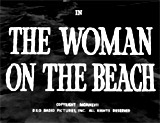
|
The Woman on the Beach (1947) (aka La Femme Sur La Plage (Fr.), or Desirable Woman) Jean Renoir's moody, overwrought and nightmarish erotic melodrama was a psychological character study about a tormented love triangle. It was the director's final American film during wartime exile. The film, Renoir's best Hollywood work, was severely edited by RKO after a disastrous preview screening, leaving it as only a fragment of what it could have been at 71 minutes. Its main femme fatale star Joan Bennett had already just starred in two back-to-back film noirs for director Fritz Lang, The Woman in the Window (1944) and Scarlet Street (1945). This film had similar themes: lust, promiscuity, loneliness, jealousy, and damaged personalities. Shell-shocked, traumatized, unbalanced and disturbed WWII Coast Guard veteran officer Lieutenant Scott Burnett (Robert Ryan) was stationed near a desolate California coastline during recuperation from post-traumatic stress due to a maritime battle tragedy (he admitted later: "I'm not well"). The patrolman was haunted by his combat days, seeing "ghosts" and suffering nightmares of a shipwreck following a torpedo attack. He dreamt that he sank into a whirlpool, was drowned and walking on the ocean floor littered with skeletons while a glowing woman beckoned to him from afar. When he approached close to the woman, he embraced her.
Scott was engaged to wholesome and sweet but bland local girl Eve Geddes (Nan Leslie), a blonde worker at the local shipyard, Bill Geddes' Boat Yard (Building & Repairing), where her father was a boat-builder. She resembled the blonde in his underwater dream. Their marriage was set to occur in two weeks. Meanwhile, while riding mounted on the foggy California beach, he sighted an unknown brunette who was smoking a cigarette seated next to an abandoned shipwreck ('woman on the beach'). During another ride shortly later, he met the vixenish siren again while she was collecting wood - she identified herself as Peggy Butler (Joan Bennett), the film's sexy femme fatale, with whom he was immediately smitten. He helped her bring a heavy stack of firewood to her isolated cliff-top house, where she lived and was married to older renowned blind painter Tod Butler (Charles Bickford). The callous wife Peggy was involved in an unhappy, imprisoning, and dysfunctional love-hate marriage to an excessively-jealous, troubled, surly and grumpy man. Tod had become embittered due to the loss of his career's livelihood ("I assure you a blind painter's just the same as a dead man") - he was unable to paint, but knew that the value of his paintings would increase due to his lack of continuing output ("Now that I can't paint anymore, this stuff of mine gets more valuable every day"). He had locked his paintings in a closet to keep them intact, while Peggy encouraged him to sell them so they could maintain a better lifestyle. He also expected that his wife was cheating on him and would soon eliminate him: "You think I need eyes to tell me you want to get rid of me? You murderous little sneak!" However, he still perversely encouraged visits by Scott to see Peggy, and wasn't 'blind' to their passion. During Scott's illicit affair with the slutty Peggy, she became more obsessively guilt-ridden as she snuck kisses and embraces, while vowing her hatred for Tod: ("Love him? I hate him"). At one point, she had met secretly with Scott in the beached, rotting ship's hull (while her unseeing husband approached the porthole - and they feared he sensed them there). Nonetheless, she still believed she had to stay with Tod because she had caused her husband's blindness (by cutting his optic nerve with a glass thrown at him) during a drunken brawl. She felt responsible for him and bound to him. As an aspiring upper-class socialite and a playgirl earlier in her life, however, Peggy felt confined by her meager, lowly, and isolated lifestyle, and immediately felt a strong attraction to the virile Coast Guardsman. Peggy and Scott both felt that that had lost something major in their lives and were haunted by "ghosts" ("Have you ever had everything and suddenly had nothing? Nothing but ghosts?"). He confided in her that they were very similar: "We're pretty much alike, aren't we?"
Paranoid about being found out, and suspecting that Tod's blindness was faked in order to manipulate Peggy, Scott took it upon himself to prove or test that Tod's blindness was not real: ("If I could prove to you that Tod wasn't really blind, would you leave him?"). In one extraordinary scene to disprove his disability, he led the painter along a cliffside and then abandoned him. Tod did fall to the beach below and injured himself with bad bruises, but not seriously. Afterwards, Scott confessed the truth of the cliff incident, and Tod (who was truly blind) accepted the apology. Peggy's past was revealed to Scott - she had been involved with Eve's deceased brother Bill, and admitted she was a nymphomaniacal seductress: ("Go on. Say it - I'm a tramp. You're just finding that out?"). She also suffered abuse at the hands of her wife-beating husband. When Tod discovered that his deceitful wife had hidden what he considered his masterpiece - a nude portrait of her, and that she was planning to secretly sell it (to use the profits to improve their living conditions), he was furious about letting go of his past: ("Everything I saw in life, I set down on canvas. If I let them go I lose the last connection to the past - strong and alive"). He slapped her repeatedly, as Scott listened to the abuse from outside. In another display of his madness and infatuation with Peggy, and his own potentially-homicidal or death-wish tendencies, during a fishing trip in a small boat during stormy conditions, Scott confronted Tod about his treatment of Peggy, and attempted to drown them by poking holes in the bottom of their boat to sink it. When the concerned Peggy alerted the Coast Guard to rescue them (one of the team members was Eve), the two were saved. In the ambiguous ending, after Peggy's obvious demonstration of her love for Scott, Tod attempted to free himself from Peggy, and his past life (and his paintings) by burning down his house ("I am free"). Tod reasoned that everything was a symbol of the obsession he had with his previous, sighted life.
Afterwards, Tod renounced his past behavior and gave Peggy and Scott his blessing. His plan was to head to New York to start a career as an aspiring writer. To his surprise, Peggy walked over to Tod to reconcile with him and join him to start a new and liberated life, while Scott left the beach - free to return to Eve. |
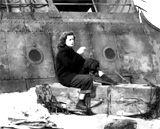 Scott's First View of "Woman on the Beach" 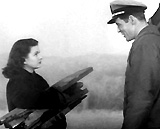 Scott's Second View of Peggy Butler (Joan Bennett)  Eve Geddes (Nan Leslie) 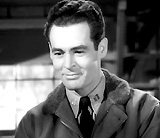 Lieut. Scott Burnett 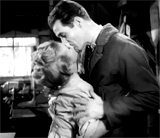 Scott and Eve - Engaged 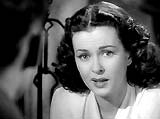 Peggy Butler (Joan Bennett) 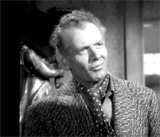 Tod Butler (Charles Bickford) 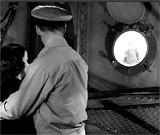 Tod Approaching Ship Porthole Where Peggy and Scott Were Having a Secret Rendezvous 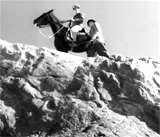 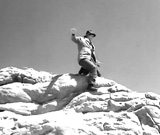 Scott Testing Tod's Blindness on Cliffside - Tod Stumbled and Fell 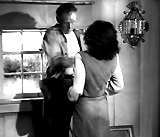 Tod Slapping Peggy For Hiding His Nude Painting of Her 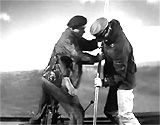 Scott's Second Attempt to Kill Tod During Fishing Trip |
|||||||||||||||||||||
Greatest Scenes: Intro | What Makes a Great Scene? | Scenes: Quiz Scenes: Film Titles A - H | Scenes: Film Titles I - R | Scenes: Film Titles S - Z |